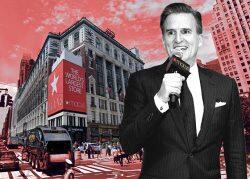Amid rising vaccination numbers and lifting of Covid-related capacity restrictions nationwide, landlords are eager to see shoppers return to brick-and-mortar stores. But retailers may have different ideas.
On their first-quarter earnings calls, executives of major retail brands said they’ve embraced the shift to e-commerce accelerated by the pandemic. Several big companies reported record-breaking sales, largely driven by the incorporation of curbside pick-up and delivery.
“This is the power of ‘and,’” Target CEO Brian Cornell said during the big-box store’s call with investors. “Guests go to Target because of our stores ‘and’ our digital options. Not one versus the other.”
In the first quarter, Target saw digital sales grow 50 percent, while sales from same-day services — such as order pickup and drive-up — rose more than 90 percent. The growth in those categories comes after last year’s massive gains of 141 percent and 235 percent, respectively.
The company’s revenue hit $24.2 billion in the first quarter, an increase of 23.4 percent over the same time last year, slightly before the pandemic set in. Investors lifted the price of Target shares by 7 percent to a record high of $221 at the end of trading on Thursday.
Similarly, Walmart is continuing to expand its online shopping and delivery services. In 2019, the company began piloting market fulfillment centers — small warehouses attached to stores, operated by robots, to manage online pick-up orders — and will be debuting more in the next two quarters.
Read more


Walmart shares jumped Tuesday as investors learned the company had smashed earnings expectations, with revenue increasing 8.6 percent year-over-year to $134.6 billion. That growth was powered by the shift toward e-commerce, as well as grocery sales and the impact of federal stimulus checks. It reported earnings per share of $1.69 for the first quarter, an improvement from $1.18 a year ago.
“Last year, there was such a shift of people that [wanted] to have deliveries shifted to home from shopping in store,” Walmart CEO John Furner said on Tuesday’s earnings call. “I think what we’ll see more this year is a balance between at-home deliveries, shopping in-store and pick up as people get back out.”
In some states, digital sales have flourished because of ongoing lockdowns. In New York, for example, capacity limitations were only lifted this week. However, other states have been operating without such restrictions for months — stores in Florida reopened at full capacity in September.
Some customers have also changed their preferences, possibly for good. In a May survey of 2,000 consumers by data firm Springboard, nearly 60 percent of respondents said they now buy at least half of their non-food items online. Twenty-one percent said that they haven’t yet shopped in person.
Amazon has most notably reaped the benefits. Net sales increased 44 percent to $108.5 billion in the first quarter, after already increasing 38 percent to $386.1 billion during the full year of 2020.
For some retailers, fewer in-person shoppers is fueling store closures. At Macy’s, for example, e-commerce accounted for 37 percent of total sales in the first quarter of 2021, up from 24 percent in 2019, while it cut operating expenses by 17 percent over the same period. It eliminated 54 stores in the year leading up to the end of the first quarter.
The brand announced last year that it would close 125 stores, and has 60 locations left on the list to shutter.
But Macy’s isn’t giving up entirely on in-person interactions. It’s testing small-format stores in suburban areas.
And in New York City, the company wants to build an office tower above its Herald Square flagship. Its CFO Adrian Mitchell said that the development will “unlock a significant amount of cash to support future initiatives.”
News of the project sank shares before robust first-quarter earnings lifted them again.
Home Depot saw net earnings for the first quarter hit $4.1 billion, a jump from the $2.2 billion from the same time last year, driven largely by the pandemic-led home improvement boom. For the company, digital sales have inspired continued investment, not closures. However, that investment is in logistics centers.
In 2017, the retailer announced it would invest $1.2 billion into its supply chain. Now, its goal is to build out enough warehouses to offer same- or next-day delivery to 90 percent of the U.S. population. It will increase its fulfillment square footage by more than 70 percent this year alone.
“The investments we have made in the business over the past decade were the right ones,” Home Depot CEO Craig Menear said during Tuesday’s earnings call.
While retailers have embraced the e-commerce trend, mall owners are not as enthusiastic.
Simon Property Group’s net operating income from its U.S. and international properties fell 8.4 percent to $1.35 billion in the first quarter. In the same period, occupancy declined to 90.8 percent from 94 percent.
On the company’s earnings call, CEO David Simon discussed the environmental benefits of physical retail compared to online shopping (and shipping). He acknowledged that retailers want digital services, but rejected store closures as a solution.
“I think they need their footprint,” Simon said. “When they close a store and that’s their store in their marketplace, they lose the e-commerce business. Or vice versa, when they open a store, their e-commerce business goes up.”
Simon, along with Brookfield Property Partners, has been saving retailers from bankruptcy (including J.C. Penney and Forever 21), which prevents its occupancy rates from falling. Simon’s share price has rebounded from a pandemic low of $55 to $122 at the end of trading on Thursday. But that’s down from a pre-pandemic high of $182.
Brookfield Property Partners — which is being taken private by its parent company, Brookfield Asset Management — experienced $2 billion in losses in 2020. Though the company did not conduct an earnings call because of the privatization process, the company reported in February that retail rent collections in the fourth quarter of last year rose to 80 percent, from 70 to 75 percent in the third quarter and 34 percent in the second quarter.
During the February call, Brookfield CEO Brian Kingston expressed some understanding that in-store foot traffic may shrink, but insisted that stores will continue to be necessary for digital channels.
“While the showroom area of the store may shrink, retailers are using more space for inventory, returns and fulfillment, making the distribution channel itself less relevant, but the location of its physical real estate more important than ever,” Kingston said.
